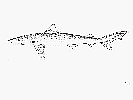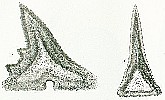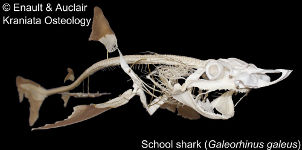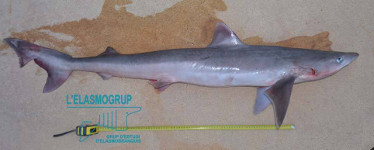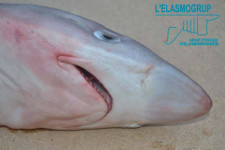Galeorhinus galeus
(Linnaeus, 1758)
Tope shark
Classification: Elasmobranchii Carcharhiniformes Triakidae
Reference of the original description
Systema Naturae per regna tria naturae, regnum animale, secundum classes, ordines, genera, species, cum characteribus differentiis synonymis, locis. Tomus I. Editio decima, reformata. Stockholm, Laurentii Salvii, 824pp.
Systema Naturae per regna tria naturae, regnum animale, secundum classes, ordines, genera, species, cum characteribus differentiis synonymis, locis. Tomus I. Editio decima, reformata. Stockholm, Laurentii Salvii, 824pp.
Image of the original description
No image in first description.
No image in first description.
Synonyms / new combinations and misspellings
Carcharhinus cyrano, Eugaleus galeus, Galeocerdo pantanellii, Galeorhinus aff. canis, Galeorhinus aff. galeus, Galeorhinus australis, Galeorhinus canis, Galeorhinus cf. australis, Galeorhinus cf. galeus, Galeorhinus cf. vitaminicus, Galeorhinus chilensis, Galeorhinus pantanellii, Galeorhinus vitaminicus, Galeorhinus zyopterus, Galeus australis, Galeus canis, Galeus cf. canis, Galeus chilensis, Galeus communis, Galeus galeus, Galeus linnei, Galeus molinae, Galeus nilssoni, Galeus pantanellii, Galeus vulgaris, Galeus zyopterus, Galeus (Galeorhinus) canis, Notogaleus australis, Notogaleus rhinophanes, Squalus galeus, Squalus rhinophanes
Carcharhinus cyrano, Eugaleus galeus, Galeocerdo pantanellii, Galeorhinus aff. canis, Galeorhinus aff. galeus, Galeorhinus australis, Galeorhinus canis, Galeorhinus cf. australis, Galeorhinus cf. galeus, Galeorhinus cf. vitaminicus, Galeorhinus chilensis, Galeorhinus pantanellii, Galeorhinus vitaminicus, Galeorhinus zyopterus, Galeus australis, Galeus canis, Galeus cf. canis, Galeus chilensis, Galeus communis, Galeus galeus, Galeus linnei, Galeus molinae, Galeus nilssoni, Galeus pantanellii, Galeus vulgaris, Galeus zyopterus, Galeus (Galeorhinus) canis, Notogaleus australis, Notogaleus rhinophanes, Squalus galeus, Squalus rhinophanes
Types
Galeorhinus galeus
XXXX: No types known;
Carcharhinus cyrano
Holotype: AMS: IA.3983;
Galeorhinus zyopterus
Paratype: ANSP: 582 (old: USFC 27190); Syntype: BMNH: 1881.3.14.255 (ex USNM) MCZ: 35949 (ex USNM 26973) USNM: 27191; USNM: 26927; USNM: 27190; USNM: 26973; ZMUC: ? (ex USNM)
Galeus australis
XXXX: No types known;
Galeus canis
Syntype: ANSP: 605 (missing, old: Bonaparte 254, ANSP 605-608);
Galeus chilensis
XXXX: No types known;
Galeus communis
XXXX: No types known;
Galeus molinae
Syntype: DBCUCH: ? (several)
Galeus nilssoni
XXXX: No types known;
Galeus vulgaris
XXXX: No types known;
Galeorhinus galeus
XXXX: No types known;
Carcharhinus cyrano
Holotype: AMS: IA.3983;
Galeorhinus zyopterus
Paratype: ANSP: 582 (old: USFC 27190); Syntype: BMNH: 1881.3.14.255 (ex USNM) MCZ: 35949 (ex USNM 26973) USNM: 27191; USNM: 26927; USNM: 27190; USNM: 26973; ZMUC: ? (ex USNM)
Galeus australis
XXXX: No types known;
Galeus canis
Syntype: ANSP: 605 (missing, old: Bonaparte 254, ANSP 605-608);
Galeus chilensis
XXXX: No types known;
Galeus communis
XXXX: No types known;
Galeus molinae
Syntype: DBCUCH: ? (several)
Galeus nilssoni
XXXX: No types known;
Galeus vulgaris
XXXX: No types known;
Description :
Citation: Galeorhinus galeus (Linnaeus, 1758): In: Database of modern sharks, rays and chimaeras, www.shark-references.com, World Wide Web electronic publication, Version 12/2025
Please send your images of "Galeorhinus galeus" to info@shark-references.com
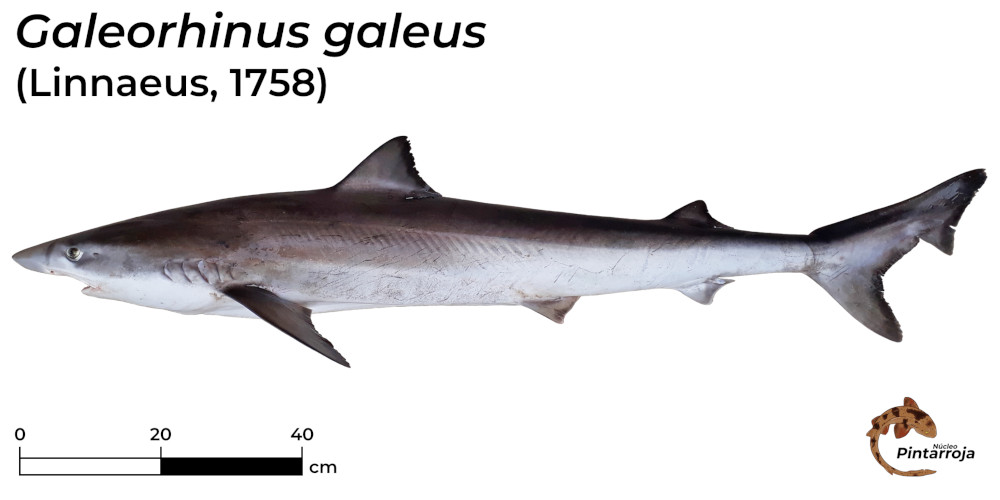
Galeorhinus galeus (Linnaeus, 1758), Chile © L. Ignacio Contreras, Laboratorio de Zoología de Vertebrados, Facultad de Ciencias, U. de Chile

Galeorhinus galeus (Linnaeus, 1758), Chile © L. Ignacio Contreras, Laboratorio de Zoología de Vertebrados, Facultad de Ciencias, U. de Chile
Common names
 Australischer Hundshai,
Australischer Hundshai,  Biethai,
Biethai,  Gemeine Meersau,
Gemeine Meersau,  Großer Hundshai,
Großer Hundshai,  Hundshai,
Hundshai,  Schulhai,
Schulhai,  Aceitero,
Aceitero,  Bostrich,
Bostrich,  Bostrio,
Bostrio,  Cazon,
Cazon,  Cazón aceitero,
Cazón aceitero,  Cazón de altura,
Cazón de altura,  Cazón dientuso,
Cazón dientuso,  Caçó,
Caçó,  Cuero,
Cuero,  Cámari,
Cámari,  Gat,
Gat,  Musola corallo,
Musola corallo,  Tiburón aceitoso,
Tiburón aceitoso,  Tiburón de aleta,
Tiburón de aleta,  Tiburón vitaminico,
Tiburón vitaminico,  Tollo,
Tollo,  Tollo cazón,
Tollo cazón,  Tollos,
Tollos,  Trompa de cristal,
Trompa de cristal,  Cagnot,
Cagnot,  Canicule,
Canicule,  Chien de mer,
Chien de mer,  Chien hâ,
Chien hâ,  Gat,
Gat,  Halt,
Halt,  Haut,
Haut,  Hâ,
Hâ,  Lamie,
Lamie,  Lamiola,
Lamiola,  Milandre,
Milandre,  Pal,
Pal,  Pallon,
Pallon,  Palloun,
Palloun,  Paroun,
Paroun,  Requin-hâ,
Requin-hâ,  Touille,
Touille,  Émissole,
Émissole,  Eastern school shark,
Eastern school shark,  Flake,
Flake,  Greyboy,
Greyboy,  Greyshark,
Greyshark,  Hundshai,
Hundshai,  Penny"s dog,
Penny"s dog,  Schnapper shark,
Schnapper shark,  School Shark,
School Shark,  School shark,
School shark,  Sharpie shark,
Sharpie shark,  Snapper shark,
Snapper shark,  Soupfin shark,
Soupfin shark,  Sweet William shark,
Sweet William shark,  Tope,
Tope,  Tope oil shark,
Tope oil shark,  Tope school shark,
Tope school shark,  Tope shark,
Tope shark,  Tope soupfin shark,
Tope soupfin shark,  Vitamin shark,
Vitamin shark,  Bistinu,
Bistinu,  Cagnassa,
Cagnassa,  Cagnizza,
Cagnizza,  Can da denti,
Can da denti,  Can negro,
Can negro,  Canesca,
Canesca,  Canoso,
Canoso,  Canuso,
Canuso,  Canuzzu,
Canuzzu,  Capucchiata,
Capucchiata,  Galeo,
Galeo,  Muzzolu,
Muzzolu,  Paccavà,
Paccavà,  Palombo,
Palombo,  Palummina,
Palummina,  Palummu,
Palummu,  Passaturi,
Passaturi,  Pesce cane,
Pesce cane,  Piscicani,
Piscicani,  Vaccotta,
Vaccotta,  Bico de cristal,
Bico de cristal,  Cação,
Cação,  Cação-bico-de-cristal,
Cação-bico-de-cristal,  Perna-de-moça,
Perna-de-moça,  Perna-de-moça da Australia,
Perna-de-moça da Australia,  Tubarão-perna-de-moça,
Tubarão-perna-de-moça,  Tubarão-vitamínico, Mazzola (malta)
Tubarão-vitamínico, Mazzola (malta)
 Australischer Hundshai,
Australischer Hundshai,  Biethai,
Biethai,  Gemeine Meersau,
Gemeine Meersau,  Großer Hundshai,
Großer Hundshai,  Hundshai,
Hundshai,  Schulhai,
Schulhai,  Aceitero,
Aceitero,  Bostrich,
Bostrich,  Bostrio,
Bostrio,  Cazon,
Cazon,  Cazón aceitero,
Cazón aceitero,  Cazón de altura,
Cazón de altura,  Cazón dientuso,
Cazón dientuso,  Caçó,
Caçó,  Cuero,
Cuero,  Cámari,
Cámari,  Gat,
Gat,  Musola corallo,
Musola corallo,  Tiburón aceitoso,
Tiburón aceitoso,  Tiburón de aleta,
Tiburón de aleta,  Tiburón vitaminico,
Tiburón vitaminico,  Tollo,
Tollo,  Tollo cazón,
Tollo cazón,  Tollos,
Tollos,  Trompa de cristal,
Trompa de cristal,  Cagnot,
Cagnot,  Canicule,
Canicule,  Chien de mer,
Chien de mer,  Chien hâ,
Chien hâ,  Gat,
Gat,  Halt,
Halt,  Haut,
Haut,  Hâ,
Hâ,  Lamie,
Lamie,  Lamiola,
Lamiola,  Milandre,
Milandre,  Pal,
Pal,  Pallon,
Pallon,  Palloun,
Palloun,  Paroun,
Paroun,  Requin-hâ,
Requin-hâ,  Touille,
Touille,  Émissole,
Émissole,  Eastern school shark,
Eastern school shark,  Flake,
Flake,  Greyboy,
Greyboy,  Greyshark,
Greyshark,  Hundshai,
Hundshai,  Penny"s dog,
Penny"s dog,  Schnapper shark,
Schnapper shark,  School Shark,
School Shark,  School shark,
School shark,  Sharpie shark,
Sharpie shark,  Snapper shark,
Snapper shark,  Soupfin shark,
Soupfin shark,  Sweet William shark,
Sweet William shark,  Tope,
Tope,  Tope oil shark,
Tope oil shark,  Tope school shark,
Tope school shark,  Tope shark,
Tope shark,  Tope soupfin shark,
Tope soupfin shark,  Vitamin shark,
Vitamin shark,  Bistinu,
Bistinu,  Cagnassa,
Cagnassa,  Cagnizza,
Cagnizza,  Can da denti,
Can da denti,  Can negro,
Can negro,  Canesca,
Canesca,  Canoso,
Canoso,  Canuso,
Canuso,  Canuzzu,
Canuzzu,  Capucchiata,
Capucchiata,  Galeo,
Galeo,  Muzzolu,
Muzzolu,  Paccavà,
Paccavà,  Palombo,
Palombo,  Palummina,
Palummina,  Palummu,
Palummu,  Passaturi,
Passaturi,  Pesce cane,
Pesce cane,  Piscicani,
Piscicani,  Vaccotta,
Vaccotta,  Bico de cristal,
Bico de cristal,  Cação,
Cação,  Cação-bico-de-cristal,
Cação-bico-de-cristal,  Perna-de-moça,
Perna-de-moça,  Perna-de-moça da Australia,
Perna-de-moça da Australia,  Tubarão-perna-de-moça,
Tubarão-perna-de-moça,  Tubarão-vitamínico, Mazzola (malta)
Tubarão-vitamínico, Mazzola (malta)
Short Description
A large houndshark with a long, pointed snout, a large mouth, and small blade-like teeth; 2nd dorsal about as large as anal fin and terminal caudal lobe as long as rest of fin [536]. Greyish above, white below; young with black markings on fins [536].
A large houndshark with a long, pointed snout, a large mouth, and small blade-like teeth; 2nd dorsal about as large as anal fin and terminal caudal lobe as long as rest of fin [536]. Greyish above, white below; young with black markings on fins [536].
Distribution
Widespread in temperate waters (Ref. 52183). Western Atlantic: southern Brazil to Argentina. Eastern Atlantic: Iceland to South Africa, including the Mediterranean. Western Indian Ocean: South Africa. Western Pacific: Australia and New Zealand. Eastern Pacific: Hawaii; British Columbia, Canada to southern Baja California and the Gulf of California in Mexico; Peru and Chile. Source: www.gbif.org
Widespread in temperate waters (Ref. 52183). Western Atlantic: southern Brazil to Argentina. Eastern Atlantic: Iceland to South Africa, including the Mediterranean. Western Indian Ocean: South Africa. Western Pacific: Australia and New Zealand. Eastern Pacific: Hawaii; British Columbia, Canada to southern Baja California and the Gulf of California in Mexico; Peru and Chile. Source: www.gbif.org
Human uses
fisheries: highly commercial; gamefish: yes; aquarium: public aquariums; price category: medium; price reliability: reliable: based on ex-vessel price for this species
fisheries: highly commercial; gamefish: yes; aquarium: public aquariums; price category: medium; price reliability: reliable: based on ex-vessel price for this species
Biology
Ovoviviparous, without a yolk-sac placenta [517]. Embryos feed solely on yolk [733]. 6 to 52 young in a litter [578]. Litter size increases with the size of the mother. Embryos reach 30-36 cm TL at birth (Ref. 6080). In the southern waters of Australia, newly born and older juveniles (30-70 cm long) aggregate in "quot;nursery areas"quot; found in shallow waters.They move to deeper coastal waters to over-winter. The following spring finds most of these young returning to their nursery areas. The older ones, aged 2 years and over move instead to eastern Bass Strait where most of the immature stock are found. The length of an average full-term embryo is 32 cm. Spawning frequency is once every year, ovulation occurring in early summer and parturition is completed by January of the following year. Gestation period lasts for about 12 months (Ref. 6390) [1388]. Occurs on the continental shelf and slope (Ref. 75154). Demersal piscivore [20063]. In the southern waters of Australia, school sharks are found in schools which are of mainly similar sex and similar size. A great part of the population migrates to the warmer waters of South Australia and New South Wales in the late summer and winter months. They return to the Bass Strait and the continental shelf around Australia during October or November (Ref. 6390). The species undertakes long migrations (movements) up to 2,500 km in the northeast Atlantic and to 1,400 km in southern Australia [1388].
Ovoviviparous, without a yolk-sac placenta [517]. Embryos feed solely on yolk [733]. 6 to 52 young in a litter [578]. Litter size increases with the size of the mother. Embryos reach 30-36 cm TL at birth (Ref. 6080). In the southern waters of Australia, newly born and older juveniles (30-70 cm long) aggregate in "quot;nursery areas"quot; found in shallow waters.They move to deeper coastal waters to over-winter. The following spring finds most of these young returning to their nursery areas. The older ones, aged 2 years and over move instead to eastern Bass Strait where most of the immature stock are found. The length of an average full-term embryo is 32 cm. Spawning frequency is once every year, ovulation occurring in early summer and parturition is completed by January of the following year. Gestation period lasts for about 12 months (Ref. 6390) [1388]. Occurs on the continental shelf and slope (Ref. 75154). Demersal piscivore [20063]. In the southern waters of Australia, school sharks are found in schools which are of mainly similar sex and similar size. A great part of the population migrates to the warmer waters of South Australia and New South Wales in the late summer and winter months. They return to the Bass Strait and the continental shelf around Australia during October or November (Ref. 6390). The species undertakes long migrations (movements) up to 2,500 km in the northeast Atlantic and to 1,400 km in southern Australia [1388].
Size / Weight / Age
193 cm TL (male/unsexed; (Ref. 40637)); 195 cm TL (female); max. published weight: 44.7 kg (Ref. 40637); max. reported age: 55 years [1388]
193 cm TL (male/unsexed; (Ref. 40637)); 195 cm TL (female); max. published weight: 44.7 kg (Ref. 40637); max. reported age: 55 years [1388]
Habitat
benthopelagic; oceanodromous [17660]; marine; depth range 0 - 1100 m [578], usually 2 - 470 m (Ref. 36731)
benthopelagic; oceanodromous [17660]; marine; depth range 0 - 1100 m [578], usually 2 - 470 m (Ref. 36731)
Remarks
shark-references Species-ID=2374;
shark-references Species-ID=2374;
Parasites (arranged by Jürgen Pollerspöck)
Myxosporea
Monogenea
Cestoda
Trematoda
Nematoda
Acanthocephala
Copepoda
Isopoda
Hirudinea
Myxosporea
Monogenea
- Cathariotrema selachii (Maccallum, 1916) Johnston & Tiegs, 1922 [33260]
- Cathariotrema sp. [31118]
- Erpocotyle canis (Cerfontaine, 1899) [9358]
- Erpocotyle catenulata (Guberlet, 1933) [31765]
- Erpocotyle eugalei (Price, 1942) [17150]
- Erpocotyle laevis Van Beneden & Hesse, 1863 [15273]
- Erpocotyle maccallumi (Price, 1942) [22589] [17150]
- Hexabothrium akaroensis Dillon & Hargis, 1965 [22557] [16602]
Cestoda
- Anthobothrium cornucopia Van Beneden, 1850 [9358]
- Anthobothrium galeorhini Suriano, 2002 [10847] [25154] [31906]
- Anthobothrium laciniatum longicolle Linton, 1891 [16245] [16602]
- Calliobothrium creeveyae Butler, 1987 [13130]
- Calliobothrium verticillatum (Rudolphi, 1819) [16408] [16314] [17089] [16101]
- Diesingium lomentaceum (Diesing, 1850) [16112]
- Gilquinia robertsoni Beveridge, 1990 [16251] [16112]
- Hepatoxylon megacephalum (Rudolphi, 1819) [16602] [21481] [16112]
- Hepatoxylon trichiuri (Holten, 1802) [21481] [16112]
- Lacistorhynchus dollfusi Beveridge & Sakanari, 1987 [16253] [16112]
- Lacistorhynchus sp. [16112]
- Lacistorhynchus tenuis (Van Beneden, 1858) [16602] [16112]
- Nybelinia sp. [16112]
- Nybelinia thyrsites Korotaeva, 1971 [16112]
- Orygmatobothrium musteli (Van Beneden, 1850) [16383]
- Scyphophyllidium giganteum (Van Beneden, 1858) Woodland, 1927 [16383] [16443]
Trematoda
- Staphylorchis pacificus (Caballero, 1945) Cutmore, Bennett & Cribb, 2010 [23771]
Nematoda
- Acanthocheilus rotundatus (Rudolphi, 1819) [31368]
- Anisakis simplex (Rudolphi, 1809) [9358]
- Anisakis sp. [16602] [10102]
- Contracaecum (Thynnascaris) sp. [16602]
- Contracaecum sp. [10102]
- Hysterothylacium aduncum (Rudolphi, 1802) [9358]
- Pseudoterranova sp. [10102]
- Raphidascaris sp. [10102]
Acanthocephala
Copepoda
- Achtheinus dentatus Wilson, 1911 [14331]
- Achtheinus oblongus Wilson, 1908 [16544] [23244]
- Achtheinus pinguis Wilson, 1912 [22641] [27172]
- Alebion difficile (Van Beneden, 1892) [26820]
- Anthosoma crassum (Abildgaard, 1794) [16602]
- Dinemoura latifolia (Steenstrup & Lütken, 1861) [16603] [16602]
- Echthrogaleus coleoptratus (Guérin-Méneville, 1837) [23244]
- Eudactylina insolens Scott & Scott, 1913 [17867]
- Kroyeria brasiliense Thatcher & Pereira, 2006 [16585]
- Kroyeria lineata Van Beneden, 1853 [17867] [16609] [34815]
- Kroyeria rhophemophaga Deets, 1994 (nomen nudum) [17867] [22489] [27172] [34815]
- Lernaeopoda bidiscalis Kane, 1892 [29249]
- Lernaeopoda bivia Leigh-Sharpe, 1930 [32531]
- Lernaeopoda galei Krøyer, 1837 [9358] [29249]
- Luetkenia integra Richiardi, 1880 (nomen nudum) [16609]
- Pandarus bicolor Leach, 1816 [16603] [16601] [16602] [7660] [16609] [9358] [15303] [23244] [27172] [33255]
- Pandarus cranchii Leach, 1819 [16603]
- Perissopus dentatus Steenstrup & Lütken, 1861 [16609]
Isopoda
- Aega serricauda Guillemin, McNab, Williamson & Bruce, 2025 [34429]
Hirudinea
- Branchellion lobata Moore, 1952 [23244]








